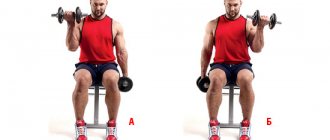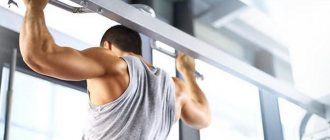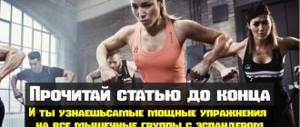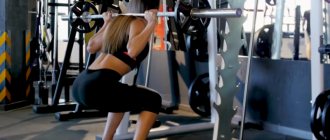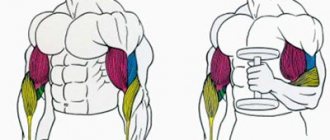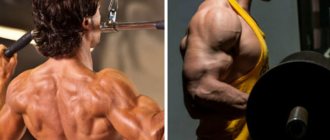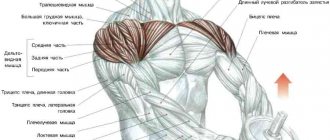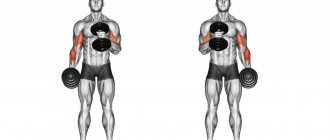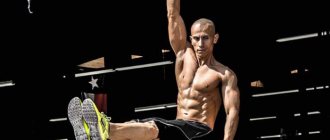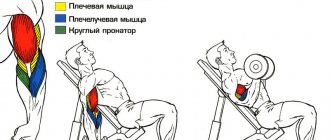Disproportional development of symmetrical muscles is a common problem. In professional sports, this phenomenon is called muscle imbalance, which refers to asymmetrical strength or volume of muscle mass on one side of the body in proportion to the other. Minor muscle asymmetry is typical for every person, and within certain limits this is a normal phenomenon. But it happens that the sizes can differ dramatically, and this is noticeable even to the naked eye. In order to eliminate such asymmetry, we must first understand its causes.
Basic exercises
Basic exercises for biceps - lifting barbells or dumbbells. The type of apparatus and grip determines exactly how the muscle is involved in the work - for example, dumbbells can be lifted either with the palm facing the ceiling or with the palms parallel to each other (pictured above).
The main secret of the technique is that when training biceps, the elbows should be motionless (beginners are recommended to press them to the belt), and the body should not sway from side to side. Plus, the speed of lifting and lowering the weight should be slow enough to perform the exercise consciously.
// Read more:
- best biceps exercises
How often should you download?
If you want to pump up your biceps as quickly as possible, train them twice a week - for example, on Monday and Friday. Start your workout with exercises for large muscle groups (back, chest, legs), and after 3-4 multi-joint exercises, move on to targeted biceps training.
As multi-joint exercises, training on a horizontal bar or with a kettlebell can be used. They are not only useful for overall strength gain, but also improve posture, put stress on the core muscles, strengthen the abs and make the figure more athletic.
A method for pumping up biceps for those who are less than 45 cm
Biceps aren't growing, what's the problem? The biceps training program contains the best exercises but you can’t see the results?
In this article we will talk about how to properly pump up your biceps .
Everyone knows that not only large biceps give volume to the arm, but even to a greater extent, the volume of the arm depends on the triceps . It is he who decides what the hand size will be.
Now let's talk about everything in order.
Biceps.
The information below will be useful to those whose arm volume, or, if you will, biceps volume (in a state of tension) is less than 45 cm.
This is not simple advice, but a professional technique on how to pump up your biceps, described in simple, understandable language.
Most people have a question about how to pump up biceps , which is not entirely true, considering that the volume of the arm depends by a third on the size of the triceps. Even more often, people are interested in how to pump up their biceps, but how to do this with something that is not there? In the sense that, according to the anatomical structure, every person has a biceps on their body, but how to pump it up when it doesn’t look decent. You can select different exercises, techniques, tips on how to properly pump up your biceps , but if you don’t have it, then you won’t be able to help with separate biceps training programs.
Here it is important to clearly understand that pump up your biceps and pump them up only when you already have them.
And while it’s not there, you shouldn’t touch it. First, the biceps must grow. To know how to properly pump your biceps, you don’t need to look for a unique program. The biceps training program at the beginning consists of two exercises: biceps curls and close-grip pull-ups. This is quite enough.
But just the wonderful complexes and programs that are often used to pump up large biceps , in the almost complete absence of it, will be useful for those who already have something to pump, or rather to pump up, developing muscle relief and peak.
Important! The arm will begin to grow on its own along with the growth of your body. Depending on genetics, you can increase your biceps by 1.3 to 2.5 cm; more precisely, the volume of your arm will increase within this range with an increase in body weight by 5 kg.
Do you want a biceps volume (meaning arm volume) in the range of 45 to 50 cm?
Then here are some recommendations for you on how to properly pump your biceps .
From the first days you should not do a whole set of biceps exercises; two basic exercises are enough.
Beginners often do additional exercises in addition to basic exercises, that is, more than two exercises for the entire arm, and thereby condemn it to stagnant growth.
In this case, the hand turns into a cornered horse, which is then difficult to increase in size to more than 42-43 cm.
To properly pump your biceps, two basic exercises are enough:
- wide grip barbell curl
- close grip bench press.
The first exercise will pump up the biceps and will fully load it. The second exercise will comprehensively load and pump the triceps. That is, you will pump exactly those two muscle groups that are responsible for the volume of your arm. This way you can reach a volume of 41-42 cm.
In combination with proper nutrition and training (we make a base from the two above exercises), we work up to a biceps volume of 45 cm. And only now can you start working on it, but you should not abuse it.
To get started, add 2 additional exercises:
- French press
- reverse close grip pull-ups.
After increasing the volume of the biceps to 47 cm, you can add one more exercise to the training program. From volume 47 cm to 49 there is very little left. You have three exercises for the large muscle groups of the arm (biceps and triceps).
Here it is, biceps size 49 cm. Now you can safely add a fourth exercise for biceps and triceps:
- dumbbell bicep curl with hammer grip
- Bent over dumbbell extension with one arm.
Here you need to understand for yourself that how can you pump up your biceps with exercises copied from the program of an athlete with arms like an elephant’s legs, and even more so, catch up with him if his set of biceps exercises is designed for slightly different goals. After all, he’s working on the fact that he’s already perfecting his biceps. The peak of the biceps, the relief of the arm and, of course, the drawing and pumping of the triceps.
Look carefully at your hands, there is something there to draw and pump up the relief and peak of the biceps.
First you need to build up the material, the base, and only then pump up all sorts of external beams and peaks.
Someone wise once said: “The sculptor took a lump of clay that he dug with just one shovel, he did not use three shovels to dig out a lump of clay for work. With just one shovel he dug up a lump of clay. When he now had material to work with and began to create, he already took tools, many different tools.
I think the hint is clear...
First prepare the material for work, and then start creating your sculpture.
And check out the best biceps exercises.
Good luck. Sports Factor.
Read further:
The best options on how to pump up your biceps at home
How to pump up your biceps for mass and definition with a barbell and dumbbells?
Brachialis (brachial muscle) learn how to pump it up and increase the volume of your biceps.
We pump up massive biceps on the Scott bench by lifting barbells and dumbbells
How to pump up big arms - select a training program and eliminate mistakes that hinder growth
Rate this article:
Share with friends on social networks:
Biceps training program
Beginning athletes often note that their biceps, having gained a certain volume, stop growing even with a constant increase in working weights and the use of isolation exercises. However, biceps training is always based on the “progress - stagnation - shift - progress” scheme.
In this case, the shift is usually achieved through the use of dropsets and supersets. Below is a training program for biceps based on complex supersets that give the muscles a powerful impulse for a shift in growth - it helps to overcome stagnation in growth and quickly pump up the biceps.
EZ-bar biceps curl
A curved barbell (or EZ barbell) helps change the mechanics of the exercise and engages the inside of the biceps—pushing the muscle up and making it bigger.
Dumbbell biceps curl
A classic biceps exercise that develops the long part of the biceps muscle. It can be performed with both palms facing upward and palms perpendicular to the floor (hammer lift).
How to deal with muscle asymmetry?
Muscle imbalances are most often detected immediately after training begins. It can be prevented or eliminated by reviewing the training program and taking into account certain recommendations:
- Use unilateral exercises . It is advisable to add exercises on one side of the body to the approved program - this will make it possible to control the speed and technique of their implementation. If possible, you should exclude exercise machines and include weight-bearing exercises in your program.
- Increase the number of repetitions . It is necessary to maintain a balance of repetitions according to the weak side of the body. You should start the approach with the lagging hand and perform it until it gives up. The result of this approach will allow the lagging part of the body to develop and catch up.
- Follow the technique . A competent form of performing exercises, taking into account the anatomical characteristics of the athlete, will help correct asymmetry. It is imperative to warm up your muscles before starting training and cool down at the end of the session.
- Strengthen internal muscles and ligaments . To do this, it is advisable to include rotation exercises with a dumbbell to strengthen the rotator cuff, side bends with a barbell on the shoulders, and a plank.
- Increase the strength of the weak side . When performing any exercise, you need to specifically increase the load on weak muscles. If there is a strong imbalance, it is worth using additional approaches for the lagging arm or increasing the number of repetitions for individual exercises.
Four Biceps Training Strategies
More than one article has been written about biceps training, however, this muscle remains a problem for many, many gym goers. In fact, even many competitive athletes have difficulty with it. In this article, we offer you four fairly simple but effective strategies to “break through” lagging biceps.
Arm exercises: biceps and triceps
Split training program for gaining muscle mass
Back muscle training program - basic and auxiliary exercises
Almost all professional bodybuilders are distinguished by phenomenal biceps development. On the one hand, this is the result of natural selection: in bodybuilding, greater success is achieved by those whose shoulders are quite short and whose biceps are attached quite low. On the other hand, it is the result of the use of pharmacology. But, according to the statement of one very famous athlete, almost all the “pros” used synthol injections into the biceps at one stage or another of their preparation. Whether this is true or not is very difficult to verify. We will assume that there was a combination of two factors. In any case, the arm of professionals is more than 52-53 centimeters in biceps volume, even if we are talking about not very tall athletes. We don’t need that much yet, so we won’t talk about synthol.
In the meantime, a little more about the pros. Step one is “rollback”.
Among professional bodybuilders, there are quite a few whose biceps “didn’t work” at the beginning of training. One of these is Tony Freeman, now one of the top ten professional bodybuilders on the planet. Almost all such athletes - and Freeman is no exception - used the tactic of “rolling back to lower weights” when training their biceps. What does such a “rollback” give? First of all, the opportunity to better feel the muscle under load - after all, too much weight when training the biceps is dispersed between many stronger muscles. The biceps should not be strong “by definition” - there is no such natural movement that would be built solely on the strength of the biceps brachii muscle. You need to feel it as much as possible - “break through”; for the growth of biceps you need to use special mechanisms.
Strategy #1: “fast, even faster!”
Surprisingly, the biceps brachii responds best to speed repetitions. The statement of many experts that for muscle growth it is best to use slow and controlled work in this case is not entirely relevant. Hence the first strategy: when training your biceps, try to use the fastest repetitions possible, both in the positive and negative phases. However, in relation to the latter, you can apply the principle of variability, alternating fast lowering of the weight with slow ones. Two-time Mr. Olympia Jay Cutler trains his biceps in a similar style. At the same time, Jay does not disdain light “cheating”, helping himself with body movements. Without them, it is difficult to quickly raise and lower weights.
Strategy #2: “get bored”
In this case, we will use not just high-volume training in relation to the biceps, but ultra-high volume! About 20 sets (and even more!) per workout for biceps growth, selecting from all conceivable exercises those that are most suitable for you (however, these biceps exercises, as a rule, copy each other, differing only in the starting position and grip). Use light weight to complete the entire intended amount of work. It is not necessary to do all the sets in a row - you can dilute the biceps training with exercises for other muscle groups. The expression “getting sick” refers to both biceps work over the course of one single training session, and training over the course of a microcycle. 3,4 and even 5 biceps workouts over the course of a week can be considered the norm. A month of hard work, followed by 7-10 days of rest - and you will definitely see the growth of your biceps.
Strategy #3: “sea of blood”
To grow your biceps, you need to find that part of the range of motion where you will feel it most strongly. Having found such a section, exclude all others from the amplitude of movement. As a rule, for biceps this is the upper half of the amplitude. And one more thing - try to additionally contract your biceps at the highest point - the load on it should be constant. Tighten your biceps in between sets as well. All this will make it possible to pump as much blood as possible into the biceps, which means dramatically increasing the delivery of nutrients to their destination and increasing the number and thickness of capillaries in this muscle. And the thickness of the muscle is determined not only by the thickness of the muscle fibers, but also by the number and thickness of the blood vessels located in the muscle.
An interesting technique: preliminary pumping of blood closer to the biceps, that is, “pumping” training of its antagonist, the triceps, prior to working on the biceps.
For the growth of biceps, a technique such as training with a tourniquet will also help. In this case, we are talking about a temporary cessation of blood outflow from the working muscle, which sharply increases the release of growth factors into the blood. A rubber tourniquet (sold in every pharmacy) is applied above the biceps and tightened so as to slow down the flow of blood, but not interfere with movement. Biceps training is performed in a very reduced amplitude - shorter than its upper half.
Strategy #4: “cuckoo method”
The key to biceps growth can also be considered the muscle that is located underneath it - the brachialis. By developing the brachialis, you seem to push the biceps outward, just like a growing cuckoo pushes its “step” brothers and sisters out of the nest. The best way to hit the brachialis is to use barbell or dumbbell curls with a pronated (fingers down) or neutral (fingers toward the body) grip.
There are not a lot of such exercises, but quite enough. Among them: Arm curls with a barbell with a reverse grip - they can be performed with both a straight and an EZ-bar, sitting with a barbell on your knees or on a Scott bench, curls with dumbbells in the “hammer” style, Bend curls on the lower block with a rope handle, bending the arms on the upper block with a reverse grip while standing or lying down. Interestingly, the weight when working on the brachialis should be greater than when pumping up the biceps, and the exercises themselves are best performed slowly and under control.
Stabilizer or indirect load
The biceps acts as a stabilizer in many exercises. Among them are the bench press, especially with a reverse grip, and dips. The indirect load obtained in such exercises, of course, cannot replace direct work on this muscle, but it will help the biceps grow quite well. The biceps are also significantly loaded when performing pull-ups - in any of their manifestations, but especially with a reverse grip. Hence the advice: never neglect bench presses and dips. And do more pull-ups.
If you liked the article, share with your friends!
